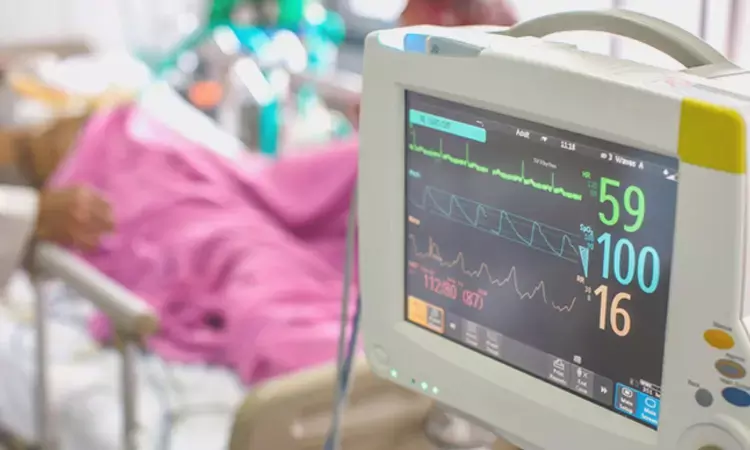- Home
- Medical news & Guidelines
- Anesthesiology
- Cardiology and CTVS
- Critical Care
- Dentistry
- Dermatology
- Diabetes and Endocrinology
- ENT
- Gastroenterology
- Medicine
- Nephrology
- Neurology
- Obstretics-Gynaecology
- Oncology
- Ophthalmology
- Orthopaedics
- Pediatrics-Neonatology
- Psychiatry
- Pulmonology
- Radiology
- Surgery
- Urology
- Laboratory Medicine
- Diet
- Nursing
- Paramedical
- Physiotherapy
- Health news
- Fact Check
- Bone Health Fact Check
- Brain Health Fact Check
- Cancer Related Fact Check
- Child Care Fact Check
- Dental and oral health fact check
- Diabetes and metabolic health fact check
- Diet and Nutrition Fact Check
- Eye and ENT Care Fact Check
- Fitness fact check
- Gut health fact check
- Heart health fact check
- Kidney health fact check
- Medical education fact check
- Men's health fact check
- Respiratory fact check
- Skin and hair care fact check
- Vaccine and Immunization fact check
- Women's health fact check
- AYUSH
- State News
- Andaman and Nicobar Islands
- Andhra Pradesh
- Arunachal Pradesh
- Assam
- Bihar
- Chandigarh
- Chattisgarh
- Dadra and Nagar Haveli
- Daman and Diu
- Delhi
- Goa
- Gujarat
- Haryana
- Himachal Pradesh
- Jammu & Kashmir
- Jharkhand
- Karnataka
- Kerala
- Ladakh
- Lakshadweep
- Madhya Pradesh
- Maharashtra
- Manipur
- Meghalaya
- Mizoram
- Nagaland
- Odisha
- Puducherry
- Punjab
- Rajasthan
- Sikkim
- Tamil Nadu
- Telangana
- Tripura
- Uttar Pradesh
- Uttrakhand
- West Bengal
- Medical Education
- Industry
Tissue perfusion pressure may predict prognosis of critically ill patients

USA: Tissue perfusion pressure (TPP) may provide an additional target for the optimization of blood pressure (BP) in patients with circulatory shock, a recent study published in Nature Medicine has revealed.
The researchers showed that TPP can predict the risk of mortality, peak blood lactate levels, and length of hospital stay.
Tissue perfusion pressure is defined as the difference between mean arterial pressure and critical closing pressure, providing unique information compared to other hemodynamic parameters.
Critically ill patients with circulatory shock-when the heart cannot pump enough blood and oxygen to the rest of the body, often as a result of heart failure, sepsis, or haemorrhage-require close monitoring and treatment, especially to maintain adequate blood pressure to prevent injury to important organs.
A team led by investigators at Massachusetts General Hospital (MGH) in collaboration with researchers at Massachusetts Institute of Technology (MIT) recently developed a method for monitoring such patients, which may help clinicians control their blood pressure and heart function to reduce the risk of death and other negative health outcomes.
The work involved designing an approach to measure a property of the circulation called the critical closing pressure, which is the blood pressure at which small blood vessels collapse and blood flow stops. Critical closing pressure can provide an indication of blood vessel tone in response to disease and therapy, but it has not been possible to measure this parameter routinely in clinical care.
Development of the new approach utilized high-resolution waveform data from blood pressure monitoring of 5,532 patients in the cardiac intensive care unit at MGH. Researchers developed an analysis based on measured parameters (including arterial pressure, pulse pressure, and heart rate) to define the critical closing pressure. They then defined a value called tissue perfusion pressure-calculated as the difference between average arterial blood pressure and critical closing pressure and found that it predicted a patient’s risk of death, length of hospital stay, and peak blood lactate level (an indicator of tissue oxygenation).
“When treating patients with circulatory shock, it is essential to maintain adequate blood pressure targets, yet standard goals are not personalized to individual patients. We have developed a new metric that can identify individuals with inadequate tissue perfusion who are at risk for adverse outcomes. We believe this method can be used to optimize treatment decisions for patients in the intensive care unit,” says senior author Aaron Aguirre, MD, PhD, an attending cardiologist and critical care specialist at MGH and an assistant professor of Medicine at Harvard Medical School.
Dr. Aguirre’s team will conduct additional studies to understand how tissue perfusion pressure varies with different therapies. They also plan to design clinical trials to test whether their new method can help guide clinical care and improve health outcomes in critically ill patients.
Reference:
Chandrasekhar, A., Padrós-Valls, R., Pallarès-López, R. et al. Tissue perfusion pressure enables continuous hemodynamic evaluation and risk prediction in the intensive care unit. Nat Med (2023). https://doi.org/10.1038/s41591-023-02474-6
Dr Kamal Kant Kohli-MBBS, DTCD- a chest specialist with more than 30 years of practice and a flair for writing clinical articles, Dr Kamal Kant Kohli joined Medical Dialogues as a Chief Editor of Medical News. Besides writing articles, as an editor, he proofreads and verifies all the medical content published on Medical Dialogues including those coming from journals, studies,medical conferences,guidelines etc. Email: drkohli@medicaldialogues.in. Contact no. 011-43720751


